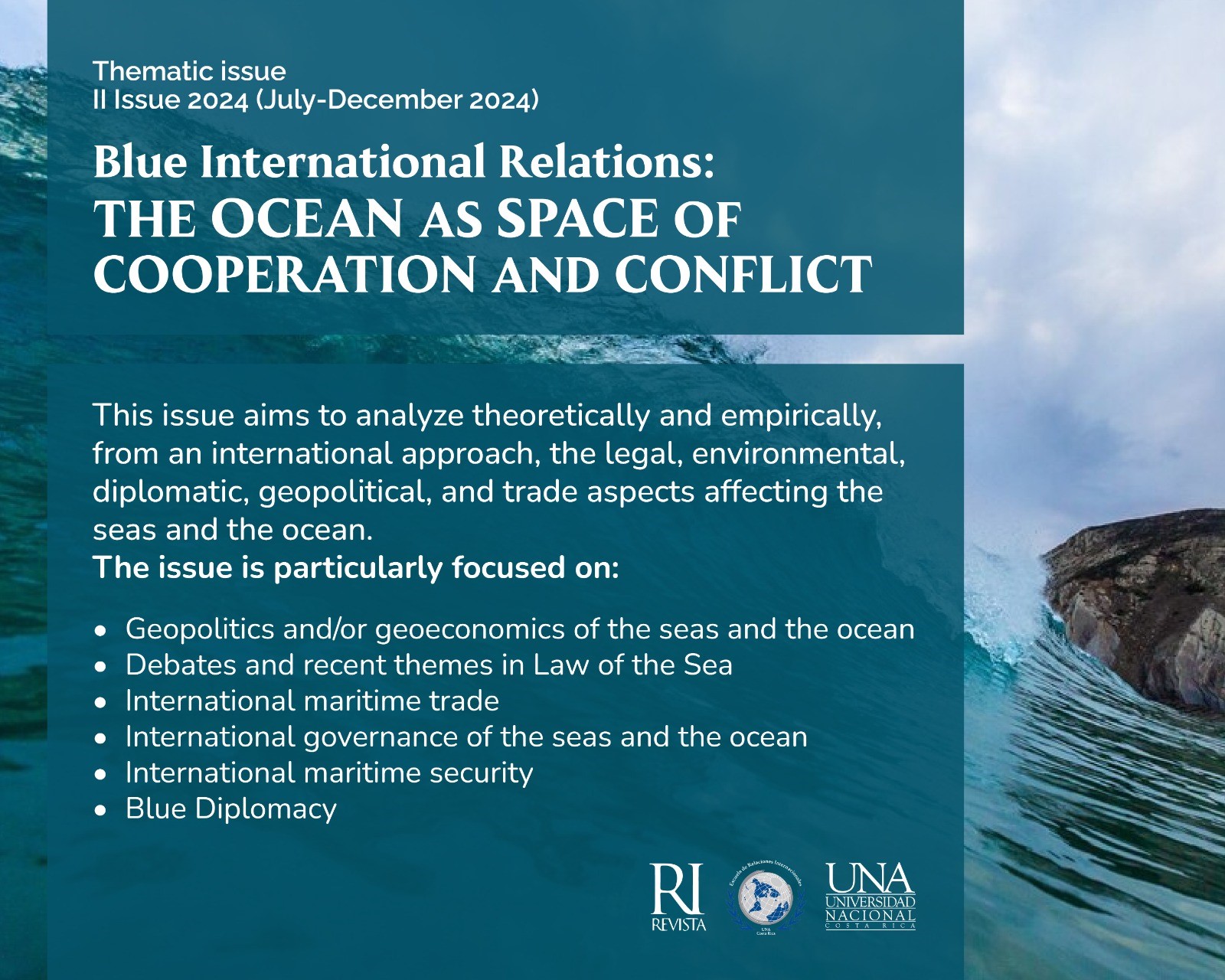China’s foreign policy: from peaceful rise to the Chinese dream – implications for international relations analysis
DOI:
https://doi.org/10.15359/97-2.2Keywords:
China, Chinese dream, foreign policy, international relations, peaceful rise, TianxiaAbstract
This article aims to examine the evolution of China’s foreign policy from the adoption of the “peaceful rise” policy to the present one which stems from the concept of the “Chinese dream” presented by Xi Jinping. The analysis is carried out in the light of major traditional international relations theories and introduces the doctrine underpinning the “Chinese dream” known as Tianxia. It finds that western traditional doctrine lacks rigorous consideration of Asian historical and cultural singularities that prevent them from fully explaining the international actions of the People’s Republic of China. In particular, China’s increasing assertiveness in its international relations along with its economic, military and technological advances, as well as the military conflicts in Ukraine and Israel, have exacerbated differences with the West. It is imperative to provide diplomacy with tools to assess the international context and the opposing positions of the West and the PRC that considers a theoretical framework that incorporates elements such as Tianxia, not as a substitute for Western tradition frameworks of analysis, but to enrich them. This is particularly true for the defense and projection of the interests of developing countries, which will require extensive diplomatic skills to navigate this complex context effectively as proactive players rather than bystanders in the international arena.
References
Banco Mundial (2024). Indicadores de Globales de Desarrollo. Banco Mundial. https://data.worldbank.org/indicator/NY.GDP.MKTP.CD?locations=CN-1W
Bellabona, P. y Spigarelli, F. (2007). Moving from open door to go global: China goes on the world stage. International Journal of Chinese Culture and Management (IJCCM), 1(1).
CFR (2024). China’s approach to global governance. Council of Foreign Relations. https://www.cfr.org/china-global-governance/
CGTN (2017). Sino-British joint declaration on HK “no longer has realistic significance”: Chinese FM. China Global Times Network. https://news.cgtn.com/news/356b7a4d31517a6333566d54/index.html.
European Commission (2019). Joint communication: EU-China-A strategic outlook. High Representative of the Union for Foreign Affairs and Security Policy. Strasbourg, https://ec.europa.eu/commission/publications/eu-china-strategic-outlook-commission-contribution-european-council-21-22-march-2019_en
Fanjul, E. (2011). El “consenso de Beijing”: universalidad y particularidad del modelo chino. La nueva geografía de la internacionalización. Revista de Economía, 859, 47-53.
Ishak, T. (2020). El “sueño chino” de Xi Jinping y sus efectos globales. Atlantic Council. https://www.aa.com.tr/es/an%C3%A1lisis/el-sue%C3%B1o-chino-de-xi-jinping-y-sus-efectos-globales/2009290
Organization of Petroleum Exporting Countries (2023). Annual Statistical Bulleting 2023. https://asb.opec.org/index.html.
Qin, Y. (2011). Development of international relations theory in China: progress through debates. International Relations of the Asia-Pacific, 11, 231-257.
Rosales, O. (2020). El sueño chino. Siglo XXI Editores Argentina.
Ruíz-Morillas, N. (2016). La gran hambruna China (1958-1962): un estudio a través de la obra de Mo Yan. Revista Ayer, 102, 197-213.
Sauvant, K. y Zintian, C. (2014). China’s regulatory framework for outward foreign direct investment. China Eocnomic Journal, 7 (1), 141-163.
Shiu, S. (2020). Tianxia: China’s Concept of International Order. Global Asia. https://www.globalasia.org/v15no2/cover/tianxia-chinas-concept-of-international-order_shiu-sin-por
State Council (2015). Notice of the State Council on Issuing “Made in China 2025”. No.28 https://www.gov.cn/zhengce/content/2015-05/19/content_9784.htm
Tah-Ayala, E. (2018). Las relaciones Internacionales desde la perspectiva social. La visión del constructivismo para explicar la identidad nacional. Revista Mexicana de Ciencias Políticas y Sociales, XIII (233), 389-404.
UNCTAD (2020). Informe sobre las inversiones en el mundo 2020. Producción industrial más allá de la pandemia, Naciones Unidas, Nueva York y Gèneve.
Vargas-Céspedes, J.P & Vailes-Hurtado, R. (2024). China en la nueva era: Tianxia centro y método de la gobernanza global. Revista Centroamericana de Administración Pública. No. 85. Octubre, 2024.
Ven-Dee Huan, W. (2013). What does World Development Indicators tell us about South-South trade? World Bank Blogs. Data Blog. https://blogs.worldbank.org/en/opendata/what-does-world-development-indicators-tell-us-about-south-south-trade.
Waltz, K. (1979). Theory of International Politics. Addison-Wesley.
Williamson, J. (13 de enero del 2004). The Washington consensus as policy prescription for development. Lecture series “Practitioners of Development”. World Bank.
World Bank (2022). Four Decades of Poverty Reduction in China - Drivers, Insights for the World, and the Way Ahead. The World Bank Group. Development Research Center of the State Council, the People’s Republic of China, Washington DC, 2022
WIPO. (6 de noviembre del 2023). World intellectual property indicators report: record number of patent applications filed worldwide in 2022. World Intellectual Property Organization, Geneva. https://www.wipo.int/pressroom/en/articles/2023/article_0013.html
Xi, J. (16 de octubre del 2022). Hold high the great banner of socialism with Chinese characteristics and strive in unity to build a modern socialist country in all respects. Report to the 20th National Congress of the Communist Party of China. https://www.mfa.gov.cn/eng/zxxx_662805/202210/t20221025_10791908.html
Xi, J. (15 de noviembre del 2023). Galvanizing our peoples into a strong force for the cause of China-U.S. friendship. Speech at welcome dinner by friendly organizations in the United States, San Francisco. https://www.mfa.gov.cn/eng/topics_665678/xjpfmgjxzmyshwtscxapec/202311/t20231116_11181557.html
Xi, J. (31 de diciembre del 2023). President Xi Jinping’s 2024 new year message. Ministry of Foreign Affairs of the People’s Republic of China.
https://www.mfa.gov.cn/eng/zxxx_662805/202312/t20231231_11215608.html
Xinhuanet (2023). The Taiwan Question and China’s Reunification in the New Era. https://english.news.cn/20220810/df9d3b8702154b34bbf1d451b99bf64a/c.html
Yellen, J. (2022). Way forward for the global economy. Remarks to the Atlantic Council. Press Release. USDT.
Zhao, T. (2005). The Tianxia System: An Introduction to the Philosophy of a World Institution. Jiangsu.
Zhao, T. (2009). Investigations of the bad world: political philosophy as the first philosophy. Renmin.
Zhao, T. (7 de febrero del 2018). Can this ancient Chinese philosophy save us from global chaos? https://www.washingtonpost.com/news/theworldpost/wp/2018/02/07/tianxia/
Zheng, B. (2005). China’s peaceful rise: speeches of Zheng Bijian 1997-2005. Brookings Institution Press.
Zheng, B. (20 de diciembre de 2006). Diez puntos de vista sobre el ascenso pacífico de China y sobre las relaciones China Europa. Real Instituto Elcano. https://www.realinstitutoelcano.org/comentarios/diez-puntos-de-vista-sobre-el-ascenso-pacifico-de-china-y-sobre-las-relaciones-entre-china-y-europa/
Published
How to Cite
Issue
Section
License

Revista de Relaciones Internacionales por Universidad Nacional de Costa Rica está bajo una Licencia Creative Commons Atribución-NoComercial-SinDerivar 4.0 Internacional








1.png)







3.png)
